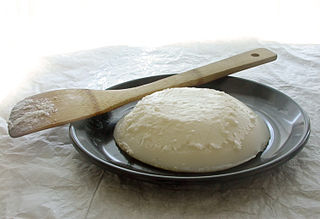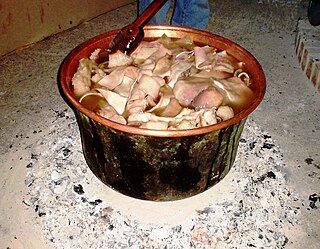
Fatback is a layer of subcutaneous fat taken from under the skin of the back of a domestic pig, with or without the skin (referred to as pork rind).

Fatback is a layer of subcutaneous fat taken from under the skin of the back of a domestic pig, with or without the skin (referred to as pork rind).
| | This section needs expansion. You can help by adding to it. (January 2024) |
Fatback is a preferred fat for various forms of charcuterie, particularly sausages and forcemeat such as quenelles.
The 1954 rhythm and blues song "Fat Back and Corn Liquor" was written by Louisiana songwriter Rudy Toombs and sung by Louis Jordan. It was released by Aladdin Records as the A side of a ten-inch 78rpm record. [1]

Forcemeat is a uniform mixture of lean meat with fat made by grinding or sieving the ingredients. The result may either be smooth or coarse. Forcemeats are used in the production of numerous items found in charcuterie, including quenelles, sausages, pâtés, terrines, roulades, and galantines. Forcemeats are usually produced from raw meat, except in the case of a gratin. Meats commonly used include pork, fish, seafood, game meats, poultry, game birds, veal, and pork livers. Pork fatback is preferred as a fat, as it has a somewhat neutral flavor.

A butcher is a person who may slaughter animals, dress their flesh, sell their meat, or participate within any combination of these three tasks. They may prepare standard cuts of meat and poultry for sale in retail or wholesale food establishments. A butcher may be employed by supermarkets, grocery stores, butcher shops and fish markets, slaughter houses, or may be self-employed.

A beef tenderloin, known as an eye fillet in Australasia, filet in France, filé mignon in Brazil, and fillet in the United Kingdom and South Africa, is cut from the loin of beef.

Cervelat, also cervelas, servelat or zervelat, is a sausage produced in Switzerland, France, Belgium, Netherlands and parts of Germany. The recipe and preparation of the sausage vary regionally.

Chicharrón is a dish generally consisting of fried pork belly or fried pork rinds. Chicharrón may also be made from chicken, mutton or beef.

Pork ribs are a cut of pork popular in Western and Asian cuisines. The ribcage of a domestic pig, meat and bones together, is cut into usable pieces, prepared by smoking, grilling, or baking – usually with a sauce, often barbecue – and then served.

Charcuterie is a French term for a branch of cooking devoted to prepared meat products, such as bacon, ham, sausage, terrines, galantines, ballotines, pâtés, and confit, primarily from pork.

Salo or slanina is a European food consisting of cured slabs of pork subcutaneous fat with or without skin and with or without layers of meat. It is commonly eaten and known under different names across Eastern and Southeastern Europe, and is traditional to multiple national cuisines in the region. It is usually dry salt or brine cured. The East Slavic, Hungarian and Romanian variety is sometimes treated with paprika or other seasonings, whereas the South and West Slavic version is often smoked.

Ace Records Ltd. is a British record label founded in 1978. Initially the company only gained permission from the similarly named label based in Mississippi to use the name in the UK, but eventually also acquired the rights to publish their recordings. When Chiswick Records' pop side was licensed to EMI in 1984, Ace switched to more licensing and reissuing work. In the 1980s it also gained the licensing for Modern Records, and its follow-up company Kent Records, whilst in the 1990s, the company bought the labels including all original master tapes.

Chicken is the most common type of poultry in the world. Owing to the relative ease and low cost of raising chickens—in comparison to mammals such as cattle or hogs—chicken meat and chicken eggs have become prevalent in numerous cuisines.

Tocino is bacon in Spanish, typically made from the pork belly and often formed into cubes in Spain. In Caribbean countries, such as Puerto Rico and Cuba, tocino is made from pork fatback and is neither cured nor smoked but simply fried until very crunchy; it is then added to recipes, much like the way lardons are used in French cuisine. In the Philippines, tocino refers to sweetened and cured pork belly.

A primal cut or cut of meat is a piece of meat initially separated from the carcass of an animal during butchering. Examples of primals include the round, loin, rib, and chuck for beef or the ham, loin, Boston butt, and picnic for pork.

Lard is a semi-solid white fat product obtained by rendering the fatty tissue of a pig. It is distinguished from tallow, a similar product derived from fat of cattle or sheep.
Pig fat is generally the fat in pork. The fatty acid composition of pork is found to be slightly different from meat of other animals, such as beef and lamb. The proportion of fat in pork can vary from 10–16%, but can be higher depending on the cut and level of trimming, among other factors.

The cuts of pork are the different parts of the pig which are consumed as food by humans. The terminology and extent of each cut varies from country to country. There are between four and six primal cuts, which are the large parts in which the pig is first cut: the shoulder, loin, belly and leg. These are often sold wholesale, as are other parts of the pig with less meat, such as the head, feet and tail. Retail cuts are the specific cuts which are used to obtain different kinds of meat, such as tenderloin and ham. There are at least 25 Iberian pork cuts, including jamón.

Salt pork is salt-cured pork. It is usually prepared from pork belly, or, more rarely, fatback. Salt pork typically resembles uncut side bacon, but is fattier, being made from the lowest part of the belly, and saltier, as the cure is stronger and performed for longer, and never smoked. The fat on the meat is necessary for the curing process as it allows the salt to soak in and preserve the meat. Salt pork is made by layering salt and thin layers of meat, then dousing it in a brine mixture once the desired size has been reached.

Frittole di maiale is a traditional dish made of pork parts in the city of Reggio Calabria and the surrounding province. Curcùci is also made in the preparation process. Frittola is a similar dish eaten in Palermo, Sicily, made from calf instead of pork.

Dressed weight refers to the weight of an animal after being partially butchered, removing all the internal organs and often the head as well as inedible portions of the tail and legs. It includes the bones, cartilage and other body structure still attached after this initial butchering. It is usually a fraction of the total weight of the animal, and an average of 59% of the original weight for cattle. There is no singular way to dress an animal, as what is removed depends on whether it will be cooked whole or butchered further for sale of individual parts. For pigs, the dressed weight typically includes the skin, while most other ungulates are typically dressed without. For fowl, it is calculated with skin but without feathers. It can be expressed as a percentage of the animal's live weight, when it is known as the killing out percentage.

Steam minced pork refers to a savory dish popular in Hong Kong and the Guangdong area of China. Consisting mainly of minced pork, it typically includes ingredients such as dried squid (土魷) and preserved cabbage (梅菜). The dish is cooked by steaming over a pot of boiling water until it is well cooked. The seasonings usually include soy sauce, salt, sugar and corn flour and occasionally white pepper and sesame oil. It is usually served with rice during lunch or dinner.

Pork rind is the culinary term for the skin of a pig. It can be used in many different ways.